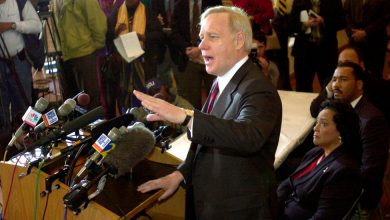The Politics of Delusion Have Taken Hold

There are very real — and substantial — policy differences separating the Democratic and Republican Parties. At the same time, what scholars variously describe as misperception and even delusion is driving up the intensity of contemporary partisan hostility.
Matthew Levendusky, a political scientist at the University of Pennsylvania, describes some of these distorted views in his recently published book “Our Common Bonds: Using What Americans Share to Help Bridge the Partisan Divide”:
At an extreme level, James L. Martherus, Andres G. Martinez, Paul K. Piff and Alexander G. Theodoridis write in a July 2019 article, “Party Animals? Extreme Partisan Polarization and Dehumanization,” “a substantial proportion of partisans are willing to directly say that they view members of the opposing party as less evolved than supporters of their own party.”
In two surveys, the authors found that the mean score on what they call a “blatant difference measure” between Republicans and Democrats ranges from 31 to 36 points. The surveys asked respondents to rate members of each party on a 100-point “ascent of man” scale. Both Democrats and Republicans placed members of the opposition more than 30 points lower on the scale than members of their own party.
“As a point of comparison,” they write, “these gaps are more than twice the dehumanization differences found by Kteily et al. (2015) for Muslims, 14 points, and nearly four times the gap for Mexican immigrants, 7.9 points, when comparing these groups with evaluations of ‘average Americans.’”
A separate paper published last year, “Christian Nationalism and Political Violence: Victimhood, Racial Identity, Conspiracy and Support for the Capitol Attacks,” by Miles T. Armaly, David T. Buckley and Adam M. Enders shows that support for political violence correlates with a combination of white identity, belief in extreme religions and conspiracy thinking.
“Perceived victimhood, reinforcing racial and religious identities and support for conspiratorial information,” they write, “are positively related to each other and support for the Capitol riot.”
Julie Wronski, a political scientist at the University of Mississippi, noted in an email that “much research has shown that Americans’ views of the other party are in fact driven by misperceptions and falsehoods.” Bringing Republicans and Democrats together and revealing their commonalities, she continued, “only lessens affective polarization. It cannot eliminate it.”
Why?
“Because humans are innately good at finding patterns and establishing stereotypes,” Wronski wrote, citing research showing that just as “Democrats overestimate the percentage of wealthy Republicans, Republicans overestimate the number of L.G.B.T.+ Democrats.”
Since these beliefs have their foundations in core values, self-image and group identities, Wronski wrote, “people are motivated to defend them. Protecting your identity becomes more important than embracing the truth.”
In other words, misperceptions and delusions interact dangerously with core political and moral disagreements.
In March 2021, Michael Dimock, the president of the Pew Research Center, published “America Is Exceptional in Its Political Divide,” in which he explored some of this country’s vulnerabilities to extreme, emotionally driven polarization:
At the same time, Dimock continued:
The result is that an individual whose party loses on Election Day can feel that his or her identity has suffered a defeat.
In separate analyses, Pew has demonstrated the scope of mutual misperception by Democrats and Republicans. In an August 2022 study, “As Partisan Hostility Grows, Signs of Frustration With the Two-Party System,” Pew found that majorities of both parties viewed the opposition as immoral, dishonest, closed-minded and unintelligent — judgments that grew even more adverse, by 13 to 28 points, from 2016 to 2022. In a June-July 2022 survey, Pew found that 78 percent of Republicans believed Democratic policies are “harmful to the country” and 68 percent of Democrats held a comparable view of Republican policies.
I asked Robb Willer, a sociologist at Stanford, about these developments, and he emailed back, “Americans misperceive the extent of policy disagreement, antidemocratic attitudes, support for political violence, dehumanization of rival partisans — again with the strongest results for perceptions of the views of rival partisans.”
Importantly, Willer continued, “misperceptions of political division are more than mere vapor. There is good reason to think that these misperceptions — or at least Democrats’ and Republicans’ misperceptions of their rivals — really matter.”
Why?
He concluded:
Willer and others who described the centrality of misperception in American politics stressed that they do not want to diminish the serious divisions between Democrats and Republicans on such matters as abortion, race, women’s rights, the safety net and the proper role of government.
Lilliana Mason, a political scientist at Johns Hopkins and the author of “Uncivil Agreement: How Politics Became Our Identity,” stressed these points in an emailed response to my questions, saying, “Democrats and Republicans are having very real and consequential disagreements on matters of equality, social hierarchy and what it means to be American.”
At the same time, Mason continued,
Alia Braley, a doctoral candidate in political science at the University of California, Berkeley, is the lead author of an August 2022 paper, “The Subversion Dilemma: Why Voters Who Cherish Democracy Participate in Democratic Backsliding.” She and her co-authors argued that “simply fearing that opposing partisans support democratic backsliding can lead individuals to support it themselves.”
In an email, Braley wrote:
Partisans, Braley continued, “overestimate how much members of the other party dislike and dehumanize them. Partisans tend to believe members of the other party want far more extreme policy outcomes than they actually do.” These misperceptions “can create a type of downward spiral in terms of polarization,” she wrote, citing Donald Trump’s claim that the 2020 election was stolen:
Gabriel Lenz — a political scientist at Berkeley and one of Braley’s co-authors — emailed to say “that much of the polarization is delusional.”
“There are two main drivers” of this phenomenon, Lenz wrote. The first “is the need for politicians to mobilize citizens with busy lives and not much of an incentive to participate in politics. There are many ways politicians can mobilize voters, but fear is tried and true.”
The second is speculative: “That humans evolved to survive conflict with the other human groups around them,” Lenz wrote. “This likely selected for people who excelled at sticking together in conflicts. Many of our biases seem explained by this incentive, especially a tendency to see the other side as evil.”
Lenz stressed the point that
Even more significant, according to Lenz, is the recognition that
Lenz cited a 2020 paper, “Malice and Stupidity: Out-Group Motive Attribution and Affective Polarization” by Sean Freeder, a political scientist at the University of North Florida, who argued that “negative motive attribution — partisans’ tendency to assume ill intent guides out-party interests” is a “key dynamic underlying affective polarization. When asked why out-party members prefer certain policy outcomes, roughly half of partisan respondents offer an explanation involving selfishness, ignorance, hatred and other negative motives.”
Freeder wrote:
Affective polarization can, in Freeder’s analysis, take on a momentum of its own:
There are other problems with efforts to lessen the mutual disdain of Democrats and Republicans.
A May 2023 paper by Diego A. Reinero, Elizabeth A. Harris, Steve Rathje, Annie Duke and Jay Van Bavel, “Partisans Are More Likely to Entrench Their Beliefs in Misinformation When Political Out-Group Members Fact-Check Claims,” argued that “fact-checks were more likely to backfire when they came from a political out-group member” and “corrections from political out-group members were 52 percent more likely to backfire — leaving people with more entrenched beliefs in misinformation.”
In sum, the authors concluded, “corrections are effective on average but have small effects compared to partisan identity congruence and sometimes backfire — especially if they come from a political out-group member.”
The rise of contemporary affective polarization is a distinctly 21st-century phenomenon.
In a July 2022 paper, “Testing the Robustness of the ANES Feeling Thermometer Indicators of Affective Polarization,” Shanto Iyengar and Matthew Tyler, both political scientists at Stanford, found that
In their paper “Partisan Gaps in Political Information and Information-Seeking Behavior: Motivated Reasoning or Cheerleading?” Erik Peterson, a political scientist at Rice, and Iyengar asked, “Do partisan disagreements over politically relevant facts and preferences for the information sources from which to obtain them represent genuine differences of opinion or insincere cheerleading?”
Their answer: “Overall, our findings support the motivated reasoning interpretation of misinformation; partisans seek out information with congenial slant and sincerely adopt inaccurate beliefs that cast their party in a favorable light.”
In an email, Iyengar warned that “The threat to democratic functioning posed by misinformation is real. The people who stormed the Capitol were not cheerleading; they genuinely believed the election was ‘stolen.’”
He wrote that of the causes of increased affective polarization, “the explanation I consider most viable is changes in the media environment.” In the 1970s, he continued, “the vast majority of the voting-age population encountered the same news stories on the same topics” — what he called “a vast information commons.”
Today, Iyengar wrote, not only are there more sources of information, but also “partisans have ample opportunity to tune in to ‘congenial sources’ — news providers delivering coverage with a partisan slant in accord with the viewer.”
Nathaniel Persily, a law professor at Stanford, wrote by email that “there are two schools of thought” concerning delusions and misperceptions in contemporary politics:
He continued, “In lab settings or other controlled environments where experts can bombard subjects with accurate information, people can move toward the center and release themselves from some of their partisan misconceptions.”
Persily wrote, however, that his analysis falls into a second school of thought:
In this context, according to Persily, “partisan polarization resembles religious polarization. Attempting to ‘disprove’ someone’s long-held religion will rarely do much to convince them that your god is the right one.”
Viewed this way, partisan affiliation is an identity, Persily wrote, “and displays dynamics familiar to identity politics”:
Jay Van Bavel, a professor of psychology and neural science at N.Y.U., shares Iyengar’s view on the key role of the changing media environment. In an email, he wrote:
People are motivated, he continued,
A significant component, Van Bavel said, “is based on misperceptions they’ve absorbed from their social network on (social) media stories. It suggests that if we could simply provide accurate and diverse portrayals of other groups, it might reduce the growing trend toward affective polarization.”
But, he cautioned, “correcting misinformation is extremely hard; the impact tends to be pretty small in the political domain, and the effects don’t last long.”
In a 2021 paper, “Identity Concerns Drive Belief: The Impact of Partisan Identity on the Belief and Dissemination of True and False News,” Andrea Pereira, Elizabeth Harris and Van Bavel surveyed 1,420 Americans to see which of the following three alternatives best explained the rise and spread of political misinformation:
Their conclusion:
There have been a number of studies published in recent years describing the success or failure of various approaches to reducing levels of misperception and affective polarization. The difficulties facing these efforts are reflected, in part, in an October 2022 paper, “Interventions Reducing Affective Polarization Do Not Necessarily Improve Antidemocratic Attitudes,” by Jan G. Voelkel, a sociologist at Stanford, and eight colleagues.
The authors found that even when “three depolarization interventions reliably reduced self-reported affective polarization,” the interventions “did not reliably reduce any of three measures of antidemocratic attitudes: support for undemocratic candidates, support for partisan violence and prioritizing partisan ends over democratic means.”
In other words, the irrational element of partisan hostility has seemingly created a political culture resistant to correction or reform. If so, the nation is stuck, at least for the time being, in a destructive cyclical pattern that no one so far has found a way to escape.
The embodiment of delusional politics is, of course, Donald Trump, with his false, indeed fraudulent, claim that the 2020 election was stolen from him. The continuing willingness of a majority of Republican voters to tolerate this delusion reflects the difficulty facing the nation as it struggles to restore sanity to American politics — if it’s not too late.
The Times is committed to publishing a diversity of letters to the editor. We’d like to hear what you think about this or any of our articles. Here are some tips. And here’s our email: [email protected].
Follow The New York Times Opinion section on Facebook, Twitter (@NYTopinion) and Instagram.




